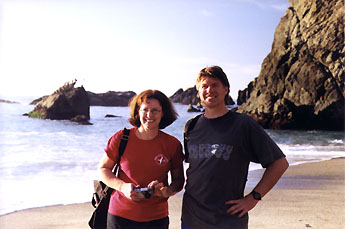

and where we're going
|
Office: MH-217C (enter MH-207)
|
Office: MH-243
|

Department of Biological Science
California State University Fullerton
P.O. Box 6850
Fullerton, CA 92834-6850
Phone: (714) 278-3614
Fax: (714) 278-3426
Summer, 2006: BIOL409
Segment D: June 5 to July 30, 2006
Students must provide their e-mail address and mailing address to
npelaez@fullerton.edu on or before the first day of the session, June 5, 2006.
Summer 2006 SYLLABUS
Summer 2006 SCHEDULE
2006 SCHEDULE FOR CPR & TEACHING PORTFOLIO MODULES
2006 TEACHING PORTFOLIO GUIDELINES AND EXAMPLES
Evolution is one of the most important and most widely misunderstood concepts in science. Teaching Evolution is an online course to help you deepen your understanding of evolutionary concepts, develop instructional strategies, and address obstacles in the teaching of evolution. It may also be of interest to anyone who would like to learn more about evolution and how to teach it. The course covers theoretical basis and strategies for improving teaching and learning about evolution in secondary school classrooms through multimedia technologies. Course credit is meant for science majors who will later pursue a Single Subject science teaching credential or for multiple subject teachers who may want to specialize to teach middle school life science. The course may be included on the study plan for a master's degree.
Teaching Evolution addresses the history of evolutionary thought and how scientists investigate the history of life on earth. The instructional strategy is to focus on “why” questions about ultimate causation: Why do specific organisms have particular features rather than others? Upon completion of this course, students will demonstrate knowledge of these causal processes of evolution: (1) to understand the origins of hereditary variations; (2) to understand how various processes act to affect the fate of those variations; (3) to understand the relative importance of the many co-acting processes of change; (4) to understand how rapidly changes occur; (5) to understand how processes such as mutation, natural selection, and genetic drift have given rise to the diverse molecular, anatomical, behavioral, and other characteristics of different organisms; and (6) to understand how populations become different species.
Pre-requisite: Completion of general education math and science courses and junior or senior standing or admission to a graduate program.
In addition to reading assignments, students must complete eight interactive online course sessions that cover rigorous evolutionary content (sessions 1-5); methodologies for teaching evolution in high school classrooms (sessions 6-7); and strategies for dealing with the controversy that sometimes arises in teaching evolution (session 8). Each session uses a variety of multimedia resources to explore different facets of evolution and teaching. The course draws on the PBS Evolution broadcast series, interactive Web activities, streaming videos illustrating concepts and instructional strategies, and a digital Evolution library to extend conceptual learning. Activities include concept mapping, reading, reflective writing, and discussion.
Enrolled students must have technology skills. Students who need a low-tech evolution course can take BIOL404. Try this self-assessment. Check out the technology requirements. Contact Nancy Pelaez with your email and mailing address to show that you can use email and to receive course materials by mail before the first week of classes!
ASSISTANCE:
Technology: Students not thoroughly familiar with Microsoft Office products may want to improve their skills with MS Word, MS PowerPoint or MS Excel before enrolling in this class. Use the Microsoft Office 2000 Tutorials for Teachers specifically designed to teach student teachers and teachers the basics of Microsoft Office 2000.
Writing: Students in BIOL 409 are expected to write using clear and grammatically correct English. Anyone who is a current student at Cal State Fullerton is welcome to use the Writing Center.
Research: For research assistance, students can make arrangements to access the Cal State Fullerton library from home.
Access: In case of home computer problems or a slow modem connection speed, students can navigate the Web and hear streaming video on campus in MH690, the Math and Science Teaching Educational Research and Service lab. Arrangements must be made with Nancy Pelaez for access to the room.
Register: ( if you are not a CSU Fullerton student) Anyone with the pre-requisites can enroll in BIOL409 through the Open University program. Questions? Call 714 278-2611. You do not need to be enrolled in a degree program at the university. Please note, however, that enrollment through Open University does not constitute admission to a degree program at Cal State Fullerton.
The syllabus and many of the course documents for BIOL409 are presented in Adobe Acrobat Portable Document Format. If you do not have the Adobe Acrobat Reader, you can download a free copy from Adobe. Adobe Acrobat Reader is required to view the PDF files completely.
TEXTBOOKS:
Required: Zimmer, Carl. Evolution, HarperCollins Publishers, New York, NY, 2001. ISBN 0060199067.
Required: Students will follow published guidelines for the development of your evolution teaching portfolio. Be sure to contact your instructor and arrange times to attend class meetings to get the guidelines.
Optional: Volpe, E.P. & Rosenbaum, P.A. Understanding Evolution, McGraw Hill, 2000. ISBN 0697051374. This books provides background information about genetic inheritance for those students who do not have a strong background in basic biological principles.
Interactive Web: © 2001 Teaching Evolution: Online Course for Teachers is a co-production of WGBH/NOVA Science Unit and Clear Blue Sky Productions, Inc.
California
State University, Fullerton
Copyright © 2001-2006. All rights reserved.
Revised:
June 01, 2006
.